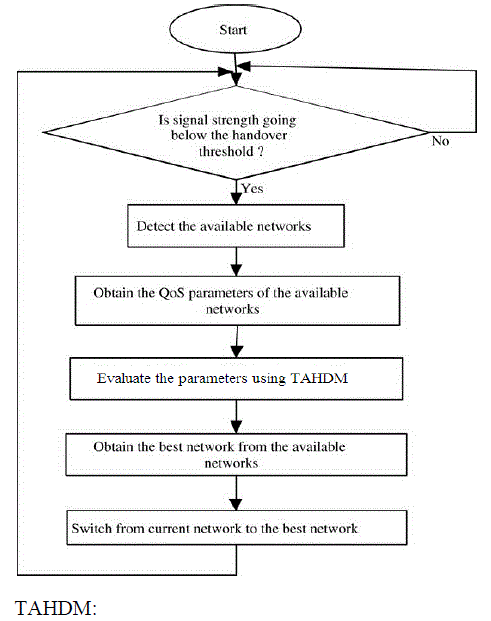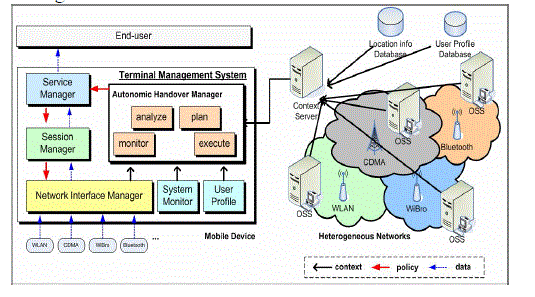ISSN ONLINE(2319-8753)PRINT(2347-6710)
ISSN ONLINE(2319-8753)PRINT(2347-6710)
| M.Ananthi1 Computer and Communication, Department of ECE, EBET Group of Institutions, Kangayam, Tamilnadu, India |
| Related article at Pubmed, Scholar Google |
Visit for more related articles at International Journal of Innovative Research in Science, Engineering and Technology
A user in 4G network needs to have a seamless vertical handover so as to backward compatible with 3G and 2G wireless networks. In the existing methods the handover is performed based on user policies at each time and by using the neural network model. This is an issue for the handover based on the time needed to take the handover and the reduction in traffic-carrying capacity. To overcome these limitations, an algorithm TAHDM has been developed where the decision is made by using the context information from the mobile node, networks and the user as well as the RSS. In this paper, a new vertical handover algorithm is developed based on the TAHDM algorithm to improve the parameters supported for vertical handover. Here the parameters handoff latency and the network load balancing are included in the algorithm to provide the seamless service to the user.
Keywords |
| Vertical Handover, 4G wireless network, Handoff Latency, Load Balancing |
INTRODUCTION |
| Growing consumer demand for access to communication services anywhere and anytime is driving an accelerated technological development towards the integration of various wireless access technologies. Such integration combines islands of access networks into a seamless system, referred to as Fourth Generation (4G) wireless systems. 4G wireless systems will provide significantly higher data rates, offer a variety of services and applications previously not possible due to bandwidth limitations, and allow global roaming among a diverse range of mobile access networks. In a typical 4G networking scenario, handsets or Mobile Terminals (MTs) with multiple interfaces will be able to choose the most appropriate access link among the available alternatives. These access links include IEEE 802.11 Wireless Local Area Network (WLAN) access, IEEE 802.16 Worldwide Interoperability for Microwave Access (WiMAX), satellite systems and Bluetooth, in addition to the traditional cellular telephony networks. For a satisfactory user experience, MTs must be able to seamlessly transfer to the “best” access link among all available candidates with no perceivable interruption to an ongoing voice or video conversation. Such ability to handover between heterogeneous networks is referred to as vertical handovers. As an important step towards achieving this objective, the emerging IEEE 802.21 standard creates a framework to support protocols for enabling seamless vertical handovers. IEEE 802.21 provides only the overall framework, leaving the implementation of the actual algorithms to the engineers designing the system. Therefore, it is essential to develop efficient vertical handover decision (VHD) algorithms to ensure the success of this new framework. |
OBJECTIVE |
| `The main objective of this paper is to provide a seamless service to the 4G mobile user based on the dynamic and non dynamic context information available on the time. When the signal strength goes below the threshold level then the automatic vertical handover is performed and the signal is changed to the available heterogeneous network for continuous service. |
EXISTING SCENARIO |
1. UARTHO |
| Use of Adaptive Resource Theory for vertical Handoff Decision in heterogeneous networks (UARTHO) A neural network model has been used to process multi-criteria vertical handoff decision metrics |
| Adaptive Resonance Theory or ART refers to a class of self organizing neural architectures that cluster the pattern space and produce appropriate weight vector templates. ART is an unsupervised paradigm based on competitive learning which is capable of automatically finding categories and creating new ones when they are needed. Conventional artificial neural networks have failed to solve the stability-plasticity dilemma. A new network remains open to new learning (remain plastic) without washing away previously learned codes. Too often, learning a new pattern erases or modifies previous training. If there is only fixed set of training vectors, the network can be cycled through these repeatedly and may eventually learn all. In a real network, it will be exposed to a constantly changing environment. |
2. PEHHWN |
| Policy-Enabled Handoffs across Heterogeneous Wireless Networks (PEHHWN) |
| The automation of switching from one network to another is based on the principle of user involvement with minimal user interaction. User involvement was required for the policy specification. Handoff decisions and operations are all done at the mobile host. Periodically, the mobile host collects current dynamic conditions, and consults with a policy module on which is the best reachable network. |
II. PROPOSED WORK |
| The vertical handover will be performed between heterogeneous networks; the need for vertical handoff can be initiated for convenience rather than connectivity reasons. The handoff latency and the load balancing parameters are also included into the TAHDM algorithm and the simulation will be shown by using the Network Simulator NS2. The latency parameter is achieved by reducing the time for the search and execution phase. The load balancing is improved by increasing the traffic capacity. |
TAHDM: |
| There are two major parts in this algorithm. Network side and terminal side. An optimal handover decision is to be achieved through their joint contributions. On the network side, the OSS of each network will perform network monitoring and report to the context server. The various repositories distributed in the networks will store the context information such as location information and user profiles. The context server located in the network collects the relevant context information from the context repositories. It prepares the evaluation matrix in response to the handover decision request from TMS. On the terminal side, the TMS will interact with the context server mentioned above for the purpose of making the optimal selection of the appropriate radio segment to which the terminal will eventually be assigned. The terminal’s estimation of signal strength and QoS levels in the system are beneficially combined for making an informed selection of the appropriate radio technologies through which services can be obtained as efficiently as possible. Thus, both the network and the terminal contribute useful information towards the optimal decision. AHM interacts with context server, system monitor and user profile repository. After processing the context evaluation, it decides on an appropriate policy and informs it to the service manager. The service manager manages the mapping of service and applications. It creates a session for each application using the policy from the AHM. The session manager maintains the created session and sends the decision of the appropriate network interface for the application to the network interface manager. The network interface manager serves two purposes. One is the retrieval of measurements at L2 level in the network interface and the other is the connection of the appropriate interface during a handover. Our management solution is located in the management layer and is independent of the OSI layers. Thus, it can control and monitor all layers. The system monitor collects the system information such as the remaining quantity of the battery and the memory. There are user settings on the services in the user profile. |
 |
| AHM provides four major functions to decide an appropriate policy by the context information. • Monitor function provides the mechanisms that collect, aggregate and filter the dynamic context from the terminal such as the received signal strength, CPU usage and remained battery. |
| • Analyze function provides the mechanisms that correlate and model complex situation. This updates the evaluation matrix from the context server by the monitored dynamic context |
| • Plan function provides the mechanisms that construct the actions needed to achieve goals and objectives. This uses policy information to guide the result of evaluating matrix. |
| • Execute function provides the mechanisms that control the execution of a plan with considerations for dynamic updates. This publishes the policy to the service manager. |
 |
III. CONCLUSION |
| Vertical hand over will be implemented for the 4G network nodes using Network Simulator. It can be used in the devices such as Laptop, Smartphone that supports for dual network. It automatically connects to the best available network among the different networks. It uses the Autonomic Computing concept where the handoff is done without the need of a user. As a future work, the handover will be performed to reduce the time and to increase the load capacity. |
References |
|